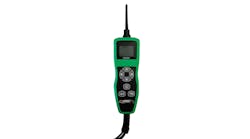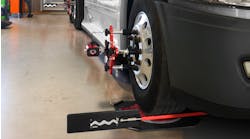The Sensor Simulator and Sensor Voltage Probe from Prologics offer various sensor diagnosis capabilities. The Sensor Voltage Probe provides four main testing functions, specifically the simulation of 0.5V ~ 7.0V (3A output) and 0.2V ~ 7.0V (150mA or 0.15A output), as well as volt measurement of up to 70V DC with a polarity check and resistance measurements up to 5K. The tool can be used in all 12V/24V systems, and with the ECM/ECU independent or with a diagnostic scanner to search for faults in sensors, connectors, or wires during troubleshooting.
Meanwhile, the Sensor Simulator can simulate various signals to test the ECM/ECU and the wiring harness on a vehicle. Suited for all vehicles with 12V/24V systems, the stimulator can simulate the Crankshaft Position, Camshaft Position, ABS, Wheel Speed, and Coolant Temperature sensors. The tool also features a hand grip for egonomics and an LED light for brighter access to wire and connector locations, and measures 9.8" by 3.1" by 7.8".
This probe was reviewed by Phil Fournier, owner of Phil’s Auto Clinic in Hemet, California.
Q: How did the tools function as far as saving you time?
A: These tools, which are substantially similar in capability, save many unnecessary parts installations if used as designed. For example, too many technicians are content to read a code, say, for a vehicle speed sensor issue on a wheel, and go straight to the recommendation and installation of a wheel bearing with a sensor integral to it.
If the problem turns out to be a wiring issue or a module issue, it turns into an ethical dilemma. Who pays for the part that was installed but didn’t solve the problem? Or do I return the part as “defective”? Either way, someone is being cheated and this tool can quickly and easily be used to simulate the signal BEFORE the part is replaced, which is a huge benefit.
Q: What kind of setup was involved before using the tools?
A: No setup was required for the tools.
Q: How easy were they to use?
A: The basic functions of the tools are simple to use. Since the tools don’t come with instructions, it seems to be assumed that the user is an experienced technician. As an experienced technician, I found the tools to be pretty easy to navigate, but I think it would be wise to at least include a simple set of instructions.
Q: How was its packaging? Did it come with any accessories?
A: The tools come in a sturdy plastic box which I wish was just a little bit larger as the leads need to be coiled up properly to fit. The only accessories are the voltage leads.
Q: Was there a manual included? If so, did you use the manual, and was the manual easy to understand?
A: No manual was included. I feel they should’ve at least had a QR code to an online manual or have a YouTube instructions video, if they wanted to go paperless.
Read more: Tool Review: Tool Aid Clamp Probe Set
Q: What features did you like?
A: I like the backlit screen and the built-in flashlight on the one model. Since I’m an automotive instructor as well, I see huge benefits in using the tool to teach entry-level technicians sensor functions without having to deal with the danger of a running engine. It’s also a great tool for demonstrating lab scope functions. I love the versatility of the wide and extremely precise ability to adjust the tool’s outputs. It’s a great improvement over my old sensor simulator tool which used basic potentiometers to simulate signals.
Q: What features didn’t you like?
A: I wish the cases were bigger. The voltmeter/ohmmeter functions are pretty basic so I don’t think I would use the tool for those kinds of functions.
Q: What types of jobs/repairs did you use these tools for?
A: I used them on a 2021 Chevy Silverado 1500 with P0521 and P0522 codes. The oil pressure indication on the scan tool varied wildly. Rather than replace the sensor and hope that was it, the simulator tool connected to the pigtail output with a specific voltage, which should have resulted in a steady pressure reading on the scan tool. It didn’t, which proved the problem was not the sensor. The problem was in a chaffed harness causing the signal wire to ground out and reading 0 psi when the actual oil pressure was completely normal.
I also used the tools on a 2010 Toyota Camry with a variable displacement compressor. Using the tools to simulate the signal going to the compressor proved the problem was in the command to the compressor and not the compressor itself.
Q: Is there any way you could think to improve or add to these tools?
A: I would add an instruction sheet or, in lieu of that, a QR code linking to web-based instructions. The tools are not hard to figure out, but I think it would be difficult for a beginner to master.
Q: On a scale of 1 to 10, how would you rate these tools overall? Why?
A: I give them a 9. If parts companies could convince technicians to use these tools in lieu of installing parts that may not be needed, the savings in returned parts would be enormous. As an automotive instructor, I can see almost endless possibilities to use this tool in a lab-type teaching environment.
Fleet Maintenance affiliate PTEN contributed this review.
This product was given to the reviewer free of charge by the manufacturer.



